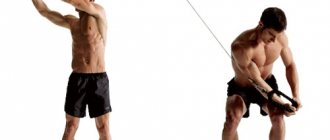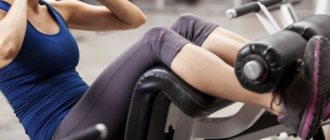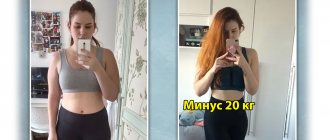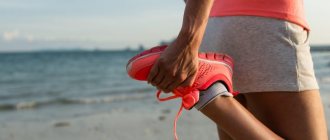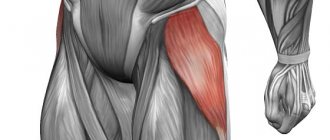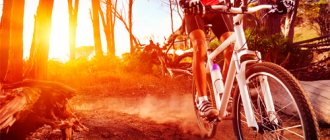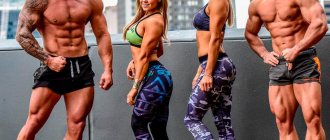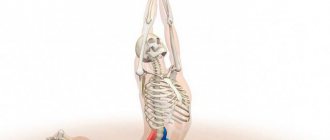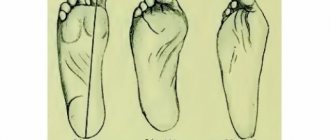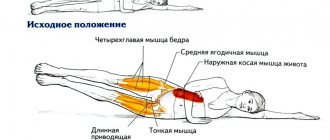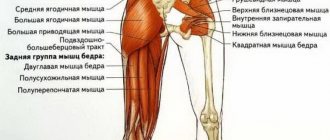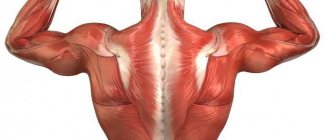Greetings, my dear girls and fitness girls!
We will remember this Friday for the fact that we will finally finish the cycle of pumping up notes and today we will learn how to pump up our legs?
After reading, you will learn all the anatomical features and secret tricks in pumping up the lower body; in the second part, we will analyze the best leg exercises and create appropriate training programs.
So, I don’t dare delay any longer, let’s start broadcasting.
How to pump up your legs: 5 training schemes.
What is the true sign of a powerful, athletic physique?
Is it a big, pointed bicep? Are these carved abdominal muscles? Is it shoulders like bowling balls or a wide, thick back? None of them are correct. The real answer is SYMMETRY. A "Symmetrical Physique" is one in which all parts of the body flow smoothly into each other. No part of the body or side of the body is larger in percentage terms than another. If this is an article about building legs, why talk about symmetry? I bring up the topic of symmetry because too many beginners and more advanced athletes alike, don't really care about training their leg muscles and skip these workouts (or just do half the task) and thereby create a terrible imbalance between the sizes of the upper and lower parts of the body. .
This completely abolishes the concept of symmetrical development of the body. There is nothing funnier than seeing a guy at the gym with well-developed upper body muscles and legs like toothpicks)))
Today you will be presented with 5 ways, 5 training schemes to make your legs strong, powerful and muscular. How to pump up your legs: 5 training schemes. Everything will be clearly stated in this article. I’ll say right away that not everyone will be able to complete these workouts - this is not an easy task, you can believe me. But if you master it, the result will be obvious!
I will talk about the anatomy of the legs, their functions, locations in the body, and some exercises for each muscle area.
Quadriceps.
Rectus femoris muscle.
- Function: Hip flexion (pulling the thigh towards the abdomen). Shin extension (leg extension at the knee)
- Location: The long fusiform muscle is located on the front of the thigh above all the other quadriceps muscles. With its upper end, the muscle is attached to the pelvic bone (lower anterior iliac spine above the acetabulum), and with its lower end it participates in the formation of the knee ligament.
- Exercises: Squats with a barbell.
Vastus lateralis muscle.
- Function: Extends the lower leg (extends the leg at the knee)
- Location: Located on the lateral surface of the thigh and extends onto the front of the thigh in the knee area. The upper end is attached to the femur in the area of the hip joint. Bottom - to the patella and tibia (tibia).
- Exercises: Hack squats.
Vastus medialis muscle.
- Function: Extends the lower leg (extension of the leg at the knee)
- Location: A thick, flat muscle located on the inside of the thigh, extending onto the front of the thigh near the knee. This muscle forms a rounded ridge on the inside of the knee, especially noticeable when you are sitting. With its upper end, the muscle is attached along the entire length (from the inside) of the femur, and with its lower end it forms the suspensory ligament of the patella.
- Exercises: Leg extensions, lunges.
Vastus intermedius muscle.
- Function: Extends the lower leg (extends the leg at the knee)
- Location: This is a flat lamellar muscle, located between the vastus lateralis and vastus medialis muscles. Hidden under their edges and covered on top by the rectus femoris muscle. The upper end of the muscle is attached to the femur in the area of the hip joint, and the lower end participates in the formation of the patellar ligament.
- Exercises: Jumping, squats, lunges.
Muscles of the back of the thigh.
Semitendinosus muscle.
- Function: Extension of the hip (pulling it back or straightening the body from a tilted position). Shin flexion (bending the leg at the knee).
- Location: A long, flat, tapering muscle lying medial (closer to the middle of the body) in relation to the biceps femoris muscle. The upper part of the muscle is attached to the ischial tuberosity of the pelvic bone. The lower one is to the tibia (lower leg).
- Exercises: Body extension, lunges, leg curls.
Semimembranosus muscle.
- Function: Extension of the hip (pulling it back or straightening the body from a tilted position). Shin flexion (leg bending at the knee)
- Location: Long flat muscle, located in the posterior inner part of the thigh. The upper end is attached to the ischial tuberosity of the pelvic bone. The lower end - to various parts of the tibia and fascia of the lower leg muscles.
- Exercise: Leg Curl.
Biceps femoris muscle.
- Function: Flexion of the shin (bending the leg at the knee). Hip extension (moving the hip back or straightening the torso from a tilted position). Maintaining body balance.
- Location: Long, spindle-shaped muscle that runs along the entire back of the thigh. It consists, as the name suggests, of two heads: long and short. The long head is attached at the upper end to the ischial tuberosity of the pelvic bone, and at the lower end to the tibia (tibia). The short upper part is attached to the back surface of the femur, and the lower part is attached to the tibia.
- Exercises: Leg bending, sitting, lying down, body extension.
Calf muscles.
Calf muscle.
- Function: Movement of the foot in the sagittal plane and stabilization of the body during movement (walking and running).
- Location: Biceps muscle on the back of the human leg. Located above the soleus muscle, together with which it is attached to the heel through the thick Achilles tendon.
- Exercises: Standing calf raises.
Soleus muscle.
- Function: Participates in flexion of the foot at the ankle joint.
- Location: The soleus muscle is attached superiorly to the head and upper third of the body of the fibula along its posterior surface, as well as to the line of the soleus muscle of the tibia; From below, the muscle is attached to the heel tubercle by the Achilles tendon.
- Exercises: Seated calf raises.
Quadriceps structure
- The femoral part of the muscle is its lateral surface and takes part in all forms of movement in which the legs are involved. It is the most circular component of this muscle bundle. It is also called the lateral muscle.
- The inner part of the thigh is formed by the vastus medialis muscle. In shape it resembles a certain roundness on the inside of the knee. The medial muscle is also designed to allow normal flexion and extension of the knee.
- Between the medial and lateral muscles is the vastus intermedius muscle, which partially extends beyond the edges of these two muscles at their junction with the knee. Mainly used when jumping and running, as well as during squats.
- On the front of the thigh is the rectus muscle, which is part of the quadriceps complex. It is longer and forms the anterior semicircular part of the thigh. It is interesting in that it is not attached to the femur, but is actively involved in the flexion and extension of the legs.
The quadriceps consists of different muscle groups, which are characterized by the speed at which different exercises are performed: slow and fast muscle fibers. As a result, exercises should have both strength and aerobic loads.
Anatomy of the quadriceps femoris muscles
The quadriceps are made up of four “heads”:
- Rectus femoris muscle. The longest of the four. Located on the front of the thigh. The upper edge is attached to the ilium, the lower edge passes into the common quadriceps tendon. Purpose: hip flexion, shin extension;
- Vastus medialis muscle. Located in the anteromedial part of the thigh. One edge is attached to the upper part of the femur, the other goes into the common tendon of the thigh. Purpose: extension of the lower leg;
- Vastus lateralis muscle. Located on the anterolateral surface of the thigh. The upper edge is attached to the trochanter of the femur, the lower edge passes into the common tendon of the thigh. Purpose: extension of the lower leg;
- Vastus intermedius muscle. Located directly under the rectus femoris muscle. One edge is attached to the upper part of the femur, the other goes into the common tendon of the thigh. Purpose: extension of the lower leg.
The structure of the quadriceps femoris muscle
Warm up your thighs before training[edit | edit code]
Warm-up
Before working your thigh muscles, you need to protect your knees by warming up all the surrounding muscles. Very often people think that to warm up their knees it is enough to warm up the quadriceps muscles, but this is a mistake! To avoid knee problems, you should start your warm-up with your calves, then move on to your quadriceps and finish with your hamstrings, in that order. Because the calf muscles attach to the femur, it is important to stretch them before working the quadriceps muscle. Additionally, to properly warm up your knees, you need to stretch the hamstrings. If you follow this simple rule, you will prevent the occurrence of knee pain or reduce the intensity of possible pain.
It's also important to work your ankle ligaments so you can keep your back as straight as possible when you do exercises like squats.
The purpose of a set of warm-up exercises
is to prepare for training (and thereby reduce the risk of injury):
- knee joints;
- quadriceps muscles;
- lower back muscles;
- posterior thigh muscle group;
- hip joints;
- shin muscles.
Perform 20-30 repetitions of the following exercises using light weights. Move from one exercise to another without resting in between. If you feel that one warm-up cycle is not enough, repeat it again.
After completing all the exercises of the general warm-up cycle, proceed to the first exercise for the quadriceps muscles of the thighs. Perform the first set of this exercise with a light weight to warm up the gluteal muscles before moving on to heavier weights. If you're already warmed up from hamstring or gluteal exercises, you don't need to do the entire warm-up exercise. However, you should do at least one quadriceps exercise as a warm-up.
Features of quadriceps muscle training
To maximally load the muscles of the anterior thighs, we recommend using the following tips:
- Add variety. Classic squats work the entire lower body. To prevent your muscles from having time to adapt to them, change the program every 10-12 weeks. Incorporate unusual exercises into your plan, such as front squats.
- Increase the number of repetitions. Many professional bodybuilders periodically use the technique of performing 20-30 repetitions per set. This also adds variety to the training and allows you to load the muscle fibers of the thighs in a different way;
- Squat “within” the amplitude. At the bottom point, do not sit below the parallel of your thighs with the floor; at the top point, do not straighten your legs to the end. This method of performing squats creates a powerful, long-lasting load on the quadriceps femoris muscles;
- Try training with supersets (working antagonist muscles in one approach). For example, do 12 barbell squats. Then immediately, without rest, lie down on the hamstring machine and do 12 calf curls;
- Use the regression method. For example, do a set with the maximum weight you can handle for 5-6 reps. With each subsequent approach, increase the number of repetitions and gradually reduce the weight of the projectile;
- Don't forget about pumping. At the end of strength training for the anterior thigh muscles, perform 1-2 exercises with light weight for a high number of repetitions. For example, do 3 sets of 25-30 reps on a leg extension machine. Read more about pumping in this article →
A set of the best workouts for legs
The exercises in this complex for slender legs are selected in such a way as to effectively work all the muscles. They will help make them elastic and toned. By eating rationally and performing the complex, you can successfully burn excess fat deposits and acquire a slim figure. This workout perfectly trains the cardiovascular and respiratory systems, and is a prevention of varicose veins. Developed muscle groups help the heart pump blood well. By doing this, you will strengthen your muscles, blood vessels and the health of the body as a whole.
Stepping onto the platform
We perform the first exercises with our own weight, practice the technique, and select a comfortable rhythm for ourselves. Can be done in several ways:
Method 1.
- We stand straight in front of the platform, arms down, shoulders slightly back. You can also bend your elbows to make this workout easier.
- We first stand on the platform with one foot, then place the second.
- We step ten times with our right foot, then the same amount with our left foot. The supporting leg should maintain a right angle.
- We stand with our backs to the wall and retreat a little from it.
- We slowly lower ourselves onto an imaginary chair. We simulate sitting on a chair for an average of thirty seconds to one minute.
- We press the back and the back of the head tightly against the wall, maintaining a right angle at the knee joint.
- Using the force of the hips and lower legs, we straighten our legs and rise. Shaking your feet, relax for thirty seconds.
Repeat three to five times.
Squats
They are an ideal load for the legs. They shape the relief and work on problem areas of the buttocks and thighs. One of the few exercises that successfully pumps up the inner thigh, develops the hip, knee and ankle joints. This is a great move for. These areas often spoil the slender line of the legs due to excess fat and undeveloped muscles. The most effective types are:
- Feet shoulder-width apart, arms extended forward, chin raised.
- Bending your knees, we lower ourselves to a position in which a right angle is formed at the knee joint.
We do ten squats with three repetitions.
2. Plie squat
Accentuates the load on the inner thigh.
- We squat with a straight back, arms can be extended forward or clasped around the shoulders.
- Feet should be wider than shoulder width, toes pointed out.
- We squat, as in the first case, not completely, at a slow pace.
We do ten squats with three repetitions. After practicing the technique, perform.
Carefully!
Deeper squats - when the buttocks approach the floor, it is dangerous to perform. This puts excess stress on the knee joints and creates a high risk of injury.
Lunges
Lunges are good for loading the thigh muscles - quadriceps, as well as the buttocks and calves. They perfectly stretch the hamstrings and gently load the leg joints. This seemingly simple exercise is included in many complexes. It trains the sense of balance and has a great effect on the cardiovascular system. Vigorous lunges help you lose extra pounds and stay in good shape.
- Stand straight, chin raised, arms down. We take a step forward with our right foot, leaning on the entire area of the foot.
- Maintain a right angle at the knee and maintain balance. The left leg is extended, the knee is close to the floor.
- We tilt the body forward a little, making sure to maintain balance.
We repeat fifteen to twenty times. When you adapt to the load and learn to follow the technique without difficulty, you can do two or three approaches at a fast pace.
This is interesting!
For variety, you can use walking lunges, taking long steps in a circle. The wider you step into the lunge, the more the target muscles are loaded.
Gluteal bridge
One of the most effective exercises for the hips and buttocks. Good for stretching the abdominal muscles.
- We lie on our backs, with our heads comfortably placed on the floor. Hands lie along the body.
- We bend our legs at a right angle,
spread our feet, and slightly turn our toes out. - Leaning on the area of the shoulder blades and feet, we raise the buttocks as much as possible. We hold the position for several counts and lower ourselves.
Can be performed using dumbbells that are placed in the front of the thighs. The use of weights increases efficiency by an order of magnitude by increasing the load.
On a note!
In this exercise, at the maximum point there should be a straight line: shoulders - stomach - knees.
Walking on your buttocks
The muscles of the hips and buttocks work, the hip joints are developed. Helps - fat deposits on the lower part of the buttocks.
- We sit down on the floor, legs straightened, feet slightly apart. We don’t lower our heads, we look ahead.
- We bend our elbows and, moving on our buttocks, move forward and backward. For a few counts - forward, and also back.
- We help ourselves by making movements with our elbows.
Repeat ten times with three approaches.
Bike
We strengthen the abs, back and front surfaces of the thighs, gently load the knee and hip joints, increase the amplitude of their movement, and eliminate stiffness. The bicycle is widely used for.
- Perform while lying on your back.
- We put our hands under our heads.
- We raise our legs slightly above the floor level and “ride a bicycle,” bending our knees one by one. The closer the hips are to the floor, the more we work the abs.
Repeat ten times with three approaches. Rest for thirty seconds between sets to relax your lower back.
Attention!
For those who have weak abdominal and lower back muscles, it is recommended to start with the bicycle with vertically raised limbs.
Scissors
The muscles of the hips, buttocks and abdomen work. They help get rid of the so-called.
- We perform it lying on the floor.
- The arms are located along the body.
- We straighten our legs and raise them above the floor level.
- At an average pace, we make movements with our legs, imitating the movements of scissor blades.
Repeat ten times with three approaches.
Calf raises (calf raises)
We load the ankle joints and calf muscles.
- We stand straight, move our shoulders back, lift our chin.
- We put our hands on our belts, rise on our tiptoes, and, pausing for three counts, lower ourselves.
- We focus on the calf area.
Repeat ten times with three approaches.
Upward and Downward Facing Dog (Post-Workout Stretch)
They are final exercises that promote flexibility and relaxation of the leg muscles. Stretches muscles, eliminates tension and spasms that can arise from overexertion. Improve metabolism, improve blood flow, increase endurance. Exercises of eastern practices are performed at a slow pace, alternating phases of tension and relaxation. You need to adapt to such an individual rhythm so that the muscles have time to completely relax. This period can range from one to three minutes.
- We get on all fours and, straightening our knees, raise our buttocks.
- The body, ideally, should form a triangle with the buttocks at the top point. Usually it is not easy to achieve such a position right away. By stretching the muscles of your back and hamstrings, you will gradually get closer to the standard.
We perform it three times, do not forget about the relaxation phases.
- Lie on your stomach and place your palms under your shoulders.
- Legs are straight. Feet slightly apart.
- With emphasis on our palms, we bend our back and look up. Hold the position for a few seconds and lower your upper body to the floor.
We perform it three times, between which there is a relaxation phase.
- Be careful if they start after training. In this case, you need to immediately stop exercising and understand the causes of the pain. To perform a special healing.
- Warm-up should always be the first stage of training.
By preparing for exercise, you will warm up your muscles and protect yourself from injury. - An important part of the training complex is proper breathing.
Exhale - tension, inhale - relaxation! - Increase the load gradually.
Remember that the intensity of training is individual for everyone. Choose the mode that suits you. - If you are not physically fit, increase the number of exercises you perform in stages
, allowing you to gradually strengthen your lower body. - Only after the body adapts to the load can a full-fledged training regimen be set.
Doctors often have to treat injuries caused by inadequate loads when performing any, even the simplest exercises. Any should alert you
The best exercises for quadriceps
Note that it is not possible to pump up voluminous quadriceps at home. This requires serious weight loads. Therefore, all the exercises discussed below are only suitable for the gym. Girls can also perform such techniques, but the loads should be moderate: 3-4 sets of 12-15 repetitions without failure.
Squats
The exercise fully engages the quadriceps muscles, but the main load falls on the medial and lateral heads .
- Raise the racks on the power frame to chest level and place the barbell on them;
- We tightly grasp the bar, “dive” under it and, rising, press the upper part of the back to the apparatus;
- Take the weight off the racks and take a couple of short steps back;
- While inhaling, we squat until our thighs are parallel to the floor;
- As you exhale, we rise with a powerful effort.
Basic quadriceps exercise
The development of this muscle group is based on the use of basic exercises that contribute to the development of strength and endurance of the athlete, associated with an increase in the volume of muscle fibers.
Refers to one of the main exercises widely used by athletes. This exercise increases the functionality of the quadriceps and also helps strengthen the muscles of the buttocks. In this process, the muscles of the back, abs and back of the thigh are involved. The effectiveness of the exercise depends on the optimal load, otherwise the exercise can lead to serious injuries if you do not start with light weights while practicing the squat technique. The technique is as follows:
- The bar of the bar should not be located in the neck, but on the back of the deltoids and trapezius.
- Keep your back straight and your shoulder blades pulled together so that the weight of the barbell is evenly distributed. The chin is directed upward so as not to provoke forward bends, which overload the lower back and can lead to injury.
- To maintain balance, your feet are positioned wider than your shoulders and your toes point to the sides.
- The exercise begins with moving the pelvis back, as if you need to squat.
- The knees of the legs should be fixed when the back of the thigh is parallel to the floor, but it can be lower. It all depends on the athlete’s level of preparation and the task at hand. The lower the squat, the more effectively the muscles are trained.
- You should rise from a squat without sudden movements, maintaining balance. When the highest point is reached, the legs do not straighten completely, but remain somewhat bent, in order to avoid injuries to the knee joint.
When doing these exercises, you should not get carried away with maximum loads. For proper quadriceps development, it may be better to replace the barbell squat with regular front squats, but also with a barbell.
This exercise is similar to the previous one, but the bar has a slightly different arrangement, which strengthens the quadriceps more. The technique for performing this exercise is as follows:
- The grip is performed with straight arms located slightly wider than the shoulder.
- The bar is located on the front of the shoulders.
- The arms are bent, and their upper parts are parallel to the floor.
- After fixing the bar in this position, a squat is performed, the technique of which is similar to the previous one.
Hack squats
Hack - a simulator designed to strengthen the quadriceps, while exercises on it reduce the load on the spine. The lower back is located on a movable base, the arms are held on the handrails, and the legs are on an inclined plane. By changing the width of the feet, you can shift the load relative to the lateral part of the hips.
- When performing the exercise, do not rush and do not make sudden movements.
- When reaching maximum load, it is not recommended to fully extend your knees.
- The entire load should fall on the quadriceps.
- You should not spread your knees beyond the line of your toes.
The main exercise that actively works the legs, but at the same time removes all the effort from the back. If the feet are placed as close to each other as possible, then the quadriceps also take part in the work.
- To avoid stress in the back area, the lower back should be pressed tightly against the seat.
- In this case, you should make sure that your knees do not fully extend and also touch your chest at the final stage of the exercise.
- If the feet are spread slightly wider, the inner rays of the thigh muscles will work more.
Lunges
Lunges can be performed with various sports objects, such as a barbell or dumbbells. This exercise is also done in the Smith machine. If you constantly alternate the options, you can achieve maximum effect. The effect will increase even more if this exercise is alternated with other exercises, such as squats.
- The feet should be parallel, but slightly wider than the hips.
- In this case, wide steps are taken, and the leg bent at the knee joint should form a right angle in relation to the floor.
- The position of the knee must be controlled: it must be motionless and not “walk” from side to side.
- The knee of the back leg is located as close to the floor as possible, but does not touch it.
- When coming out of a lunge, the quadriceps works as much as possible.
When using a barbell, you should strictly follow the barbell technique described above in the text under the subheadings “barbell squats.” If dumbbells are used, then the arms are parallel to the body and are motionless.
Sample training program for quadriceps
We recommend training your quadriceps on the same day as your other lower body exercises. Strength training on the legs should not be done more than once a week, as there is a risk of overtraining.
- Warm-up part: exercise bike, treadmill or jump rope (5-7 minutes);
- Calf raises in the simulator (3/20-25);
- Barbell squats (4/6-8);
- Leg press in the simulator (3/10-12);
- Lunges with weights (3/10-12);
- Leg extension in the simulator (3/10-12);
- Lying leg curls in the simulator (3/10-12).
At the end of your workout, we recommend performing a few simple stretching exercises. Stretching will help relieve muscle tightness and reduce delayed post-workout pain.
Exercises to develop the vastus medialis muscle
Vastus medialis exercises aim to build strength and flexibility in the knee muscles and thereby help restore healthy knee function. In the next article we'll look at some of the exercises that can help.
The knee is an important organ of our body, so all the major functions that we perform with the help of our legs, including walking, running and jumping, as well as several others, all depend on the knees. This is why it is important to have strong and flexible legs, and that includes your knees. The vastus medialis muscle is a part of the general thigh muscle located on the inside of the kneecap. This muscle is responsible for moving the knee until it is fully bent or straightened. In people with strong knees, the muscle fibers of the vastus medialis are active throughout the entire range of motion. But when there is a problem with the contraction of these muscles, causing the muscles to tighten in stages, the result is unstable knee action. This occurs due to weakening of muscle fibers and can be caused by injury from a fall, for example. As a result, we end up with improper functioning of the knee, which affects other parts of the body, leading to pain and discomfort.
Health and yoga
The vastus medialis muscle is part of the quadriceps femoris muscle.
Anatomy and function of the vastus medialis muscle
Below (distally) it is attached through the patella and its ligament to the tibia.
Above (proximally), the vastus medialis muscle is attached along the entire posterointernal surface of the femur to the lower part of the intertrochanteric line, the medial lip of the linea aspera, the upper part of the medial epicondyle line, to the tendons of the adductor magnus and longus muscles, as well as to the medial intermuscular septum of the thigh.
Be sure to watch this video!
https://youtu.be/ASEKKAmGn0o
The vastus medialis muscle crosses only one joint - the knee (as well as the vastus lateralis muscle, as well as the vastus intermedius muscle), and participates in its extension, firstly, by extending the lower leg when fixing the thigh
and secondly, by extending the hip while fixing the lower leg.
Vastus medialis trigger points
There are two areas in the vastus medialis muscle where triggers are most common. The first trigger point is often located closer to the knee on the anterior medial surface and reflects pain along the front surface of the knee.
The second trigger point, located above, reflects aching pain along the anterior surface of the knee and lower thigh.
The long-term existence of trigger points in the vastus medialis muscle can lead to significant weakening of the muscle. The pain can be replaced by severe weakness, leading to the knee giving way, which can result in loss of balance and injury. Also, as a result of prolonged tension of the vastus medialis muscle, the patella can move inward and upward from its normal position.
You can see ways to eliminate trigger points at home, as well as get acquainted with exercises for stretching the vastus medialis muscle and useful recommendations in this video.
Exercises to strengthen leg muscles
These exercises can be done at home:
- Walk, run, or jog for at least 30 minutes a day.
- Tiptoe raise: Stand straight with your toes pointing forward. Rise up on your tiptoes and lower yourself down.
- Curl your fingers as if you want to grab something from the floor.
- Walking on your toes for 1-2 minutes.
- Squats: hands on hips - exhale, returning to the starting position - inhale.
- Running in place on your toes, 30-60 sec.
- Jump on your toes 3-15 times.
- Lying on your back, swing your arms and legs at the same time as a beetle does when turned on its back. This exercise improves blood circulation and warms up the entire body.
- We freeze with our legs raised: starting position: lying on your back, hands under your head. Raise your legs at a 45° angle, point your toes out and hold this position for 5 seconds and lower them. Slowly bend your legs, gradually pressing them towards your stomach, and also slowly straighten them.
- Bike. Starting position: lying on your back. Raise your legs at an angle of 45° and make movements that imitate the process of riding a bicycle, first forward and then in reverse order. Repeat the exercise, leaning slightly first on your left side and then on your right side. Repeat 15-20 times for each position.
- Scissors. Starting position: lying on your back. Raise your legs at an angle of 45° and spread them alternately to the sides and crosswise, first lying straight, and then, similar to the previous exercise, alternately, slightly leaning to the side, left and right. Repeat 8-10 times for each position.
Many of us probably spend most of our time pumping up those muscle groups that are “in plain sight” and the rest of the time on smaller muscles and those that we don’t want to pump up at all. I mean the calf muscles
. If the bench press benches are “worn to holes,” then the calf training machines are mostly empty and covered with a thick layer of dust. But in vain.
Well-developed calf muscles not only look beautiful, but also provide significant assistance in many basic exercises, namely squats and deadlifts. However, rarely do any athletes try to pump them up. And the main reason for this is the conviction that training the legs is a waste of time, they say, you won’t get much mass from them, and training the legs will still make them look better. They won't! These muscles can and should be trained separately!
